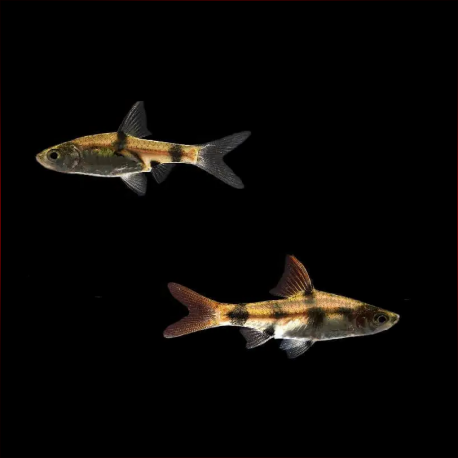More info
Datasheet
| Minimum Tank Size | 40 litres / 10.57 US gallons |
| Maximum Size | 2.5cm / 0.98inches |
| Temperature | 18°C / 64.40°F - 24°C / 75.20°F |
| Hardness | 1.01dgH / 18ppm - 10.03dgH / 179ppm |
| pH | 6.0-7.0 |
Behaviour
The Pethia Aurea is known for its peaceful demeanor, yet it is not an ideal community fish due to its small size and timid nature. It thrives best when housed either alone or with other diminutive species such as Microdevario, Trigonostigma, smaller Danio, Lepidocephalichthys, and freshwater shrimp of the genera Caridina and Neocaridina. A schooling species by nature, maintaining a group of at least 8-10 specimens is highly recommended. Keeping them in decent numbers reduces their nervousness, enhances their coloration, and encourages natural behavior patterns, including males displaying their best colors and engaging in competitive behaviors to attract female attention.
Feeding and Diet
The Pethia Aurea is presumed to be a micropredator in the wild, feeding on small insects, worms, crustaceans, and zooplankton. In an aquarium setting, they accept appropriately sized dried foods but should not be exclusively fed with them. Offering daily meals of small live and frozen foods like Daphnia, Artemia, along with high-quality flakes and granules enhances their coloration and promotes breeding activity. This varied diet ensures optimal health and vitality in these fish.
Reproduction & Dimorphism
Like most small cyprinids, Pethia Aurea are egg-scattering free spawners without parental care. To maximize breeding success, a separate breeding aquarium dimly lit and with suitable spawning substrates should be set up. Ideally, slightly acidic to neutral water with a slightly warmer temperature is favorable for breeding. Mature females tend to be rounder-bellied, slightly larger, and less vibrant in color compared to males.
Habitat and Distribution
Pethia Aurea are predominantly found in ponds within the South 24 Parganas District of West Bengal state, northern India, specifically in the Ganges River delta region. They prefer sluggish waters and are accustomed to environments with floating plants and driftwood to diffuse light. Maintaining stable water conditions within the parameters of 18-179ppm hardness, pH of 6.0-7.0, and a temperature range of 18-24°C is crucial for their well-being. A biologically mature and well-aquascaped setup with gentle filtration is essential for their health and longevity.
(See table for specific aquarium setup details)

